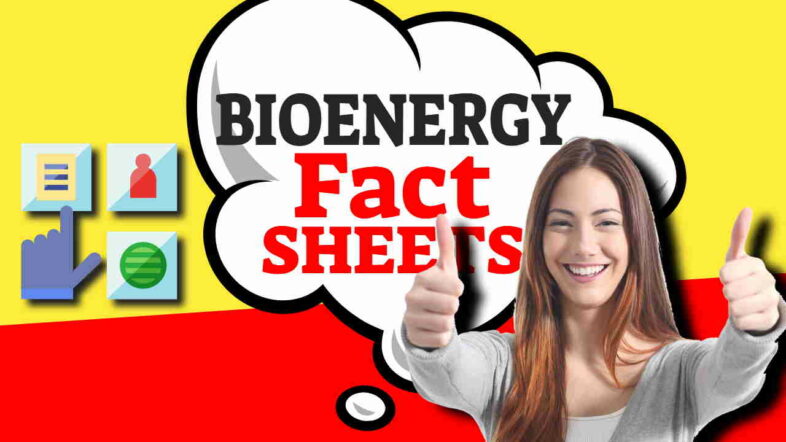Bioenergy Factsheets are a great starting point for obtaining information on renewable energy options for those just starting out on any project to investigate ways to improve the “green” performance of any company’s operations.
The foremost bioenergy source is biomass which in effect absorbs the sun’s rays as its inexhaustible renewable energy source. So, for this article read “biomass” as the paramount bioenergy source.
Biomass is a renewable resource that can be used for a huge number of energy applications. These include heat, electricity, and transport fuel. Biomass feedstock, is, for example, harvested from working Southern US forests and can be used in several ways. Factsheets provide detailed information on the current status of the renewable energy industry and the technologies that are available.
The World Bioenergy Association has recently released a biogas supply bioenergy factsheet that discusses current and future biogas supply, including electricity, heat, and transportation fuels. The factsheet is part of a five-part series on biogas and other renewable energy sources. Factsheets are also available for many other topics, making them an easy reference for those interested in bioenergy.
Bioenergy Factsheets are a valuable resource for both educators and industry professionals. They provide detailed information about the technology and can be used to explain the benefits of biofuels to the public. The information in these factsheets is free to download. Although users are required to provide personal information, this information is used internally by the WBA and will never be shared.
While the technology can produce energy and carbon-negative fuels, it is important to recognize that the process involves significant risks. But for the planet to achieve sustainable development goals developing and promoting sustainable bio-feedstocks, sustainable biomass supply chains, and reliable carbon-storage systems will be essential. In addition, sustainable agricultural policies and practices are required to ensure the sustainability of biofuel and biomass production and sourcing. Cost-sharing agreements can help manage local costs while promoting global benefits.
Biomass fuels are available in many forms, including wood, algae, and animal products. The most common method of conversion is through direct combustion.
However, there are many advantages to adopting the anaerobic digestion process for high water content biomass and food wastes.
In addition, biomass can also be converted into renewable liquid or gas fuels by thermochemical processes. These processes include gasification and pyrolysis. They differ in the temperatures involved and the amount of oxygen present during the conversion process.
Irish Bioenergy Association Launches Factsheet to Promote Bioenergy Sectors
On September 1, 2022, the Irish Bioenergy Association (IrBEA) launched a bioenergy factsheet series. The goal of the factsheet series is to inform a broad range of stakeholders about the various forms and aspects of this type of renewable energy.
The titles in the series to date are:
- Bioenergy – An Overview;
- Wood and Solid Biomass Fuels;
- Biogas;
- Biofuels;
- Biochar;
Seán Finan, CEO of the Irish Bioenergy Association said:
“We are delighted to launch our bioenergy factsheet series as a knowledge transfer and information resource for the promotion of the different bioenergy sectors. While other renewable energies are easier for the public to comprehend (e.g., wind or solar), bioenergy is made up of a wide range of technologies and fuels and can be utilised to provide heat, electricity, and transport fuels.”
Bioenergy makes up 67.2% of all renewable energy across the world.
Benefits of Bioenergy Factsheets
According to the Intergovernmental Panel on Climate Change (IPCC), bioenergy is the largest current contributor to renewable energy and is expected to remain so for at least the first half of this century.
Bioenergy plays an important role in carbon removal and emission reduction, as well as the development of bioenergy-based fuel alternatives for fossil fuels. It has the potential to supplement the food, fibre, and forestry product sectors.
According to IrBEA, bioenergy in Ireland requires investment, support, and the right policy measures to ensure the sector’s long-term viability.
“The bioenergy factsheets and the ongoing work of IrBEA in each of the sectors covered is particularly relevant in the current crisis of high fossil energy prices, security of energy supply, urgent need for decarbonisation and climate action,” said IrBEA president Paddy Phelan.
The Irish bioenergy sector is unique in that it can provide a local energy solution to all of today’s problems.
“Bioenergy can generate continuous, storable, and dispatchable renewable energy that is delivered through local supply chains, creating job opportunities and economic activity,” he added.
IrBEA was established in 1999. Its role is to promote and develop the bioenergy industry on the island of Ireland.
Farmers and foresters, fuel suppliers, energy development companies, equipment manufacturers and suppliers, legal firms, consultants, planners, research organisations, local governments, plus education and advisory bodies are all members.
Improving public awareness, including through publishing bioenergy factsheets, networking, and information sharing, as well as liaising with similar interest groups, are key areas of work carried out by IrBEA in promoting bioenergy as an environmentally, economically, and socially sustainable energy.
A Discussion of Factors For and Against the Development of Bioenergy
Biomass is a renewable organic material derived from plants and animals that is a rich source of bioenergy. It can be burned to generate heat and electricity, or it can be converted into biofuels like biodiesel and ethanol that can be used to power vehicles.
The climate impact of bioenergy varies greatly depending on where and how biomass feedstocks are sourced. For example, burning wood for energy emits carbon dioxide; however, those emissions can be significantly reduced if the harvested trees are replaced by new trees in a well-managed forest, as the new trees absorb carbon dioxide from the air as they grow.
The establishment and cultivation of bioenergy crops, on the other hand, can displace natural ecosystems, degrade soils, and consume water and synthetic fertilisers. One-third of all wood used for fuel is harvested in an unsustainable manner.
Harvesting, drying, and transporting bioenergy feedstocks typically requires significant amounts of energy; the energy used in these processes may emit greenhouse gases. In some cases, the effects of land-use change, cultivation, and processing can result in higher overall carbon emissions from bioenergy than from fossil fuels.
The use of farmland for biomass production may result in less land available for food production. In the United States, corn-based ethanol has replaced about 10% of motor gasoline, requiring a significant portion of the harvest.
Clearing forests in Malaysia and Indonesia to produce palm oil for biodiesel has had serious social and environmental consequences, as these forests are critical carbon sinks and habitats for a variety of species.
Because photosynthesis only captures a small fraction of the energy in sunlight, producing a given amount of bioenergy necessitates a large amount of land in comparison to other renewable energy sources.
Second-generation biofuels derived from non-food plants or waste reduce competition with food production, but they may have other negative consequences, such as trade-offs with conservation areas and local air pollution.
Algae, waste, and crops grown on unsuitable soil for food production are all relatively sustainable sources of biomass. If the biomass source is agricultural or municipal waste, it can be burned or converted into biogas to be disposed of.
Emissions from bioenergy power plants can be captured using carbon capture and storage technology. This process is known as bioenergy with carbon capture and storage (BECCS), and it has the potential to remove net carbon dioxide from the atmosphere.
However, depending on how the biomass material is grown, harvested, and transported, BECCS can result in net positive emissions. BECCS deployment at the scales described in some climate change mitigation pathways would necessitate the conversion of large amounts of cropland.





